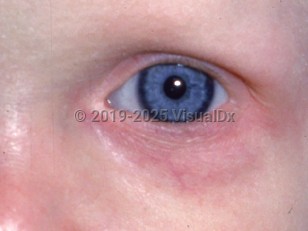Hypohidrotic ectodermal dysplasia in Child
Alerts and Notices
Important News & Links
Synopsis

Hypohidrotic ectodermal dysplasia (HED), also known as anhidrotic ectodermal dysplasia and Christ-Siemens-Touraine syndrome, is one of over 200 ectodermal dysplasias characterized by the abnormal development of ectodermal tissues. HED is characterized by malformations of the skin, hair, nails, teeth, lacrimal and salivary glands, and, in particular, eccrine sweat glands.
HED is the most common form of ectodermal dysplasia, affecting approximately 1 in 20 000 newborns worldwide. It is a genetically heterogeneous disease that can result from mutations in one of several genes. Mutations in the gene encoding ectodysplasin A (EDA) account for approximately half of all cases and follow an X-linked recessive inheritance pattern. Of note, female carriers can also exhibit mild dental abnormalities and patchy distribution of functional sweat glands. Other gene mutations (EDAR, EDARADD, WNT10A) found in HED are inherited in an autosomal dominant or recessive fashion, but are less common. The phenotypes resulting from mutations in EDA compared with the other canonical genes affected in HED are clinically indistinguishable.
Patients with HED have a reduced or absent ability to produce sweat due to abnormal formation of eccrine sweat glands in the skin. Since sweating is a major mechanism of thermoregulation, individuals with HED can experience severe hyperthermia depending on their activity level and environmental factors such as the ambient temperature and humidity. Newborns may experience problems with thermoregulation due to an inability to produce sweat. This can manifest clinically as hyperthermia, fever of unknown origin, or febrile seizures. Of note, these defects of thermoregulation in early infancy can result in a mortality rate as high as 30%. Infants can also present with poor growth. Recurrent respiratory infections are common as well and are thought to be due to abnormal airway mucous gland secretions.
Affected individuals have sparse and malformed hair that is brittle and lightly colored. Dental abnormalities such as missing or malformed teeth are also common. Certain affected individuals will have characteristic facial features including a flattened nasal bridge, prominent forehead, thickened lips, and dark, wrinkled skin around the eyes. Many are also affected by chronic eczema.
HED is the most common form of ectodermal dysplasia, affecting approximately 1 in 20 000 newborns worldwide. It is a genetically heterogeneous disease that can result from mutations in one of several genes. Mutations in the gene encoding ectodysplasin A (EDA) account for approximately half of all cases and follow an X-linked recessive inheritance pattern. Of note, female carriers can also exhibit mild dental abnormalities and patchy distribution of functional sweat glands. Other gene mutations (EDAR, EDARADD, WNT10A) found in HED are inherited in an autosomal dominant or recessive fashion, but are less common. The phenotypes resulting from mutations in EDA compared with the other canonical genes affected in HED are clinically indistinguishable.
Patients with HED have a reduced or absent ability to produce sweat due to abnormal formation of eccrine sweat glands in the skin. Since sweating is a major mechanism of thermoregulation, individuals with HED can experience severe hyperthermia depending on their activity level and environmental factors such as the ambient temperature and humidity. Newborns may experience problems with thermoregulation due to an inability to produce sweat. This can manifest clinically as hyperthermia, fever of unknown origin, or febrile seizures. Of note, these defects of thermoregulation in early infancy can result in a mortality rate as high as 30%. Infants can also present with poor growth. Recurrent respiratory infections are common as well and are thought to be due to abnormal airway mucous gland secretions.
Affected individuals have sparse and malformed hair that is brittle and lightly colored. Dental abnormalities such as missing or malformed teeth are also common. Certain affected individuals will have characteristic facial features including a flattened nasal bridge, prominent forehead, thickened lips, and dark, wrinkled skin around the eyes. Many are also affected by chronic eczema.
Codes
ICD10CM:
Q82.4 – Ectodermal dysplasia (anhidrotic)
SNOMEDCT:
239007005 – Hypohidrotic X-linked ectodermal dysplasia
Q82.4 – Ectodermal dysplasia (anhidrotic)
SNOMEDCT:
239007005 – Hypohidrotic X-linked ectodermal dysplasia
Look For
Subscription Required
Diagnostic Pearls
Subscription Required
Differential Diagnosis & Pitfalls

To perform a comparison, select diagnoses from the classic differential
Subscription Required
Best Tests
Subscription Required
Management Pearls
Subscription Required
Therapy
Subscription Required
References
Subscription Required
Last Reviewed:07/09/2019
Last Updated:01/17/2022
Last Updated:01/17/2022
Hypohidrotic ectodermal dysplasia in Child

